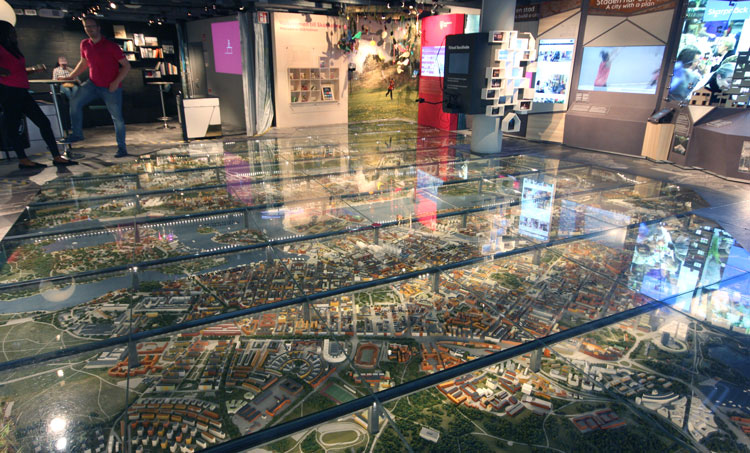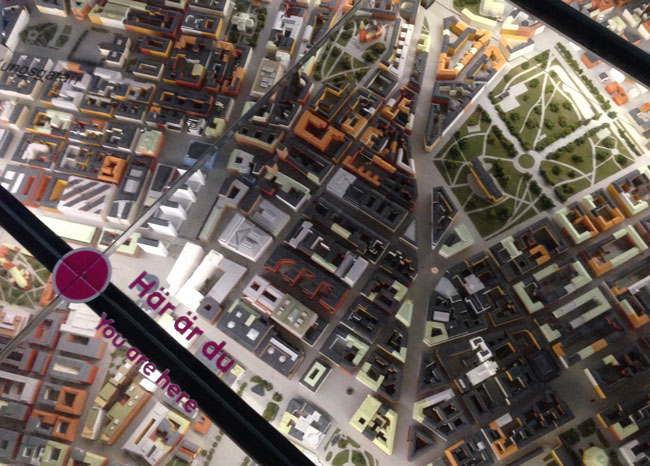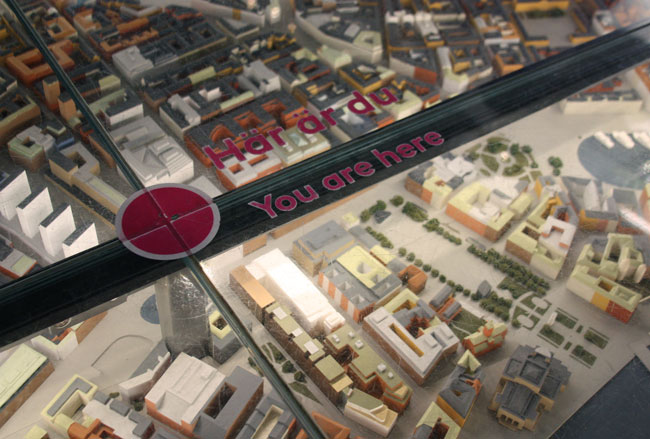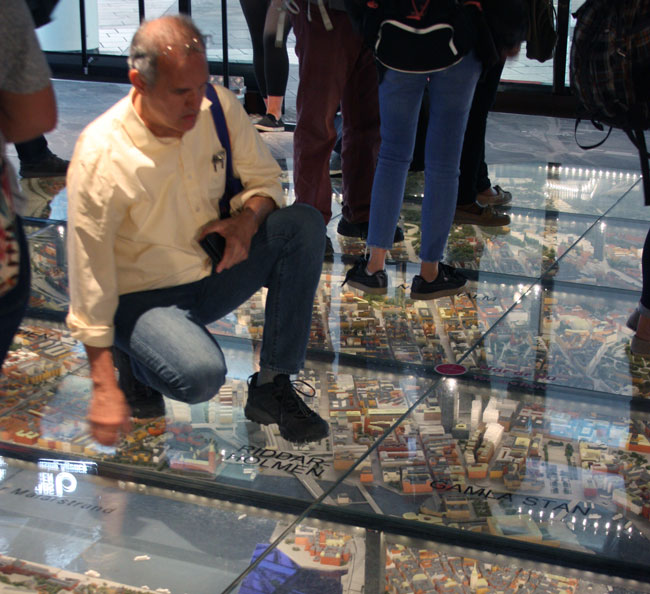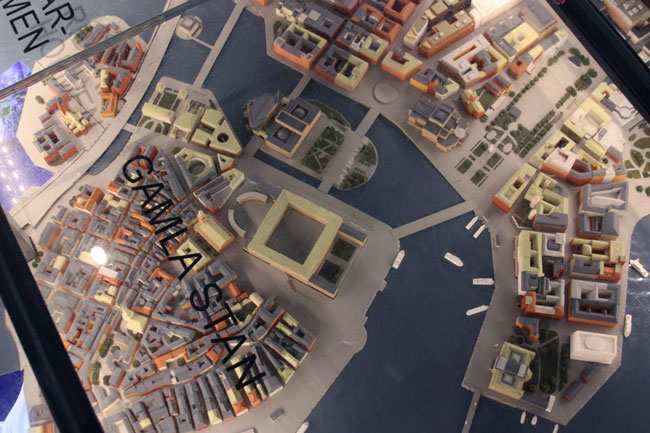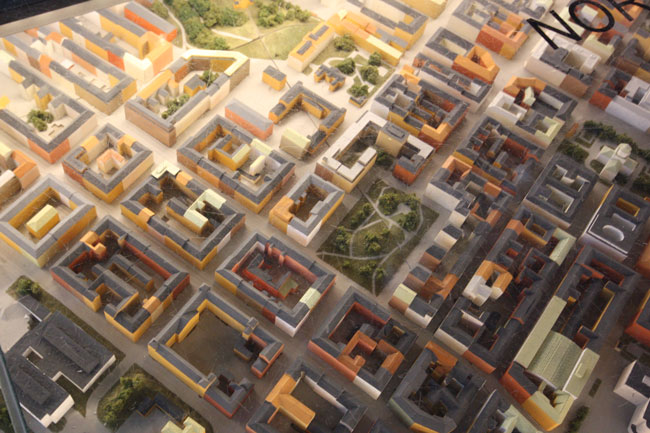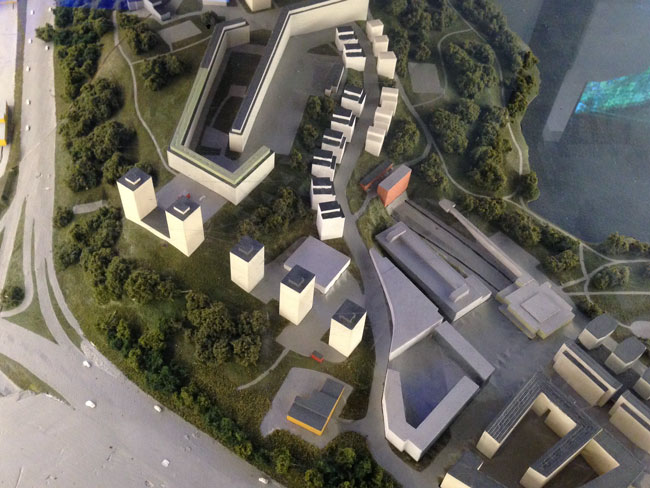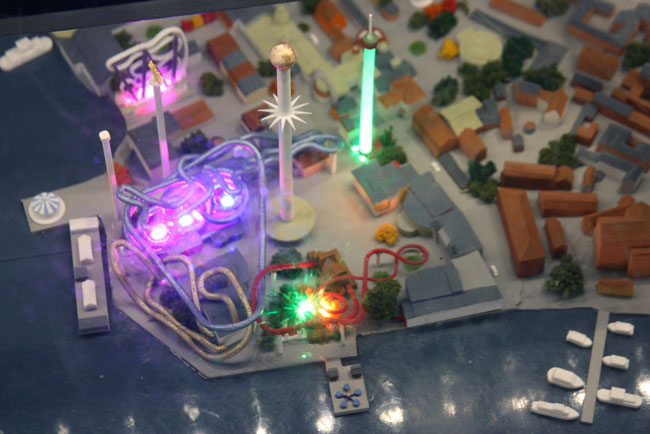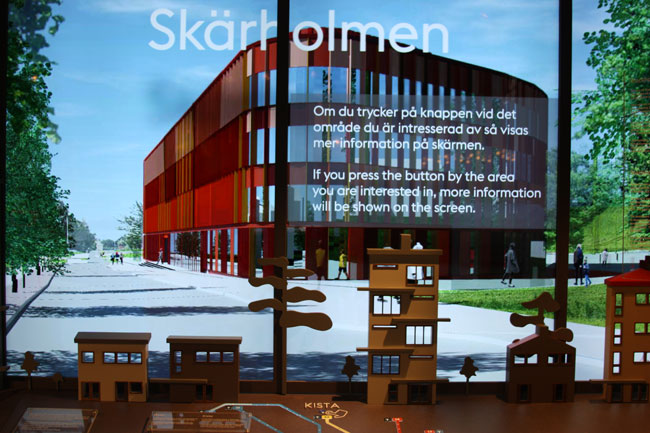|
Stockholm's Kulturhuset (House of Culture), built in 1974, is a cultural center which houses the state theater, a children's library, puppet theater, art galleries, and other performance spaces. On the lower level of the building, the Stockholmsrummet displays a large model of the city.
The 1:1000 scale model was created by the Swedish architectural model firm Mitekgruppen in 2005 using the then-new technique of 3D printing. After printing, the buildings were hand-painted and glued in place. The model currently contains nearly 5000 buildings and is a little more than 600 square feet in size.
The model was kept in storage for a few years before it found a home at the Kulturhuset in 2015. In the Stockholmsrummet, a glass floor was placed over the model to allow visitors a closer look. As there are few skyscrapers in Stockolm and the buildings are relatively even in height, there is about a foot of clearance between the glass and the tops of the buildings. A painted circle marks "Här är du" or "You are here" at the center of the model where the Kulturhuset is located.
The Kulturhuset, the long grey building where the steel post above smashes through the right half, was one of the last developments completed in a massive urban renewal project from the 1940s to 1970s to create a modernist central business district for the city. After the central railroad station was built in the 1860s just to the left of the image above, the Norrmalm district developed rapidly with apartments, offices and government buildings. By the 1930s, the neighborhood had become less-desirable, with an overcrowded population living in deteriorating, out-dated housing. Urban-planners dreamed of a building a wider north-south street to flow traffic through the city, and a plan for expanding a subway line which had been started in the south end of the city in the 1930s meant that many houses would need to be demolished. In the early 1950s the plans were in place and demolition of over 700 buildings began.
Although the glass floor allows up-close examination of different miniature neighborhoods, one drawback is that its hard to get an overview of the entire city, which is ordinarily one of the most interesting benefits of looking at large city models. When I visited, a teacher was giving a talk about the history of the city to a group of students, but it was difficult to follow along with his remarks because the feet and bodies of the students blocked the view of what he was talking about. Photos online show that the model was previously displayed un-covered in another gallery at the Kulturhuset, allowing visitors a better chance to see the full extent of the model city in a glance.
Stockholm is built on 14 islands along a waterway connecting Lake Mälaren to the Baltic Sea. Wooden piling foundations found in the old town (Gamla Stan seen above) have been dated to around 1000. Presumably a fort or castle was built here on the site of the present-day Stockholm Palace (the large square building above) to guard and control trade at the narrow part of this important waterway. In the 1600s the city grew along with Sweden's power in the Baltic region, but after the Great Northern Wars ended in 1721 the city went into a decline of plague and poverty for over a century until the improvements of the industrial revolution in the mid 1800s.
By the late 1800s Stockholm's population was increasing and the city expanded north and south of the old town in orderly streets and apartment blocks. The apartments here in Norrmalm are typical storgårdskvarter or large apartment blocks built around a central garden or courtyard. Many of them have intriguing interior houses which are not visible from the street, but can be seen in the model. The park at the center is the Tegnérlunden Park where there are memorial statues to Astrid Lindgren, who lived on Dalagatan street near the left of the photo, and August Strindberg, who lived on Drottningatan street a block to the right of the park.
After the 1930s, such large apartment blocks and gridded streets had fallen out of favor. Meant to be affordable housing with access to more space and light, this new functionalist style of architecture became popular throughout Scandinavia, just as Corbusier's house in a garden idea influenced affordable housing around the world. The small island of Reimersholme is seen here.
Newer developments such as these rows of towers and long blocks in Gröndal form interesting shapes on the model, without much detail. What are these places like in real life? On the left side are some of the few cars depicted in the model, driving on wide roads without much traffic.
The only area of the model that has some simple lighting effects is the tiny replica of Gröna Lund on Djurgården Island, a classic old amusement park dating from 1883. The rollercoasters and rides are depicted by twisted wires, along with the 400-foot tower of the "Eclipse" swing ride topped with a gold ball, and green Catapult tower ride.
The walls around the model exhibit a few interactive displays about housing issues in Stockholm. There is also a 3D virtual reality display that shows an overview of the city. Though I did not examine the VR display, perhaps this is a better way to get an overall view of the city's structure, since the entirety of the model is difficult to see under the glass floor. Visit other mini cities around the world |








